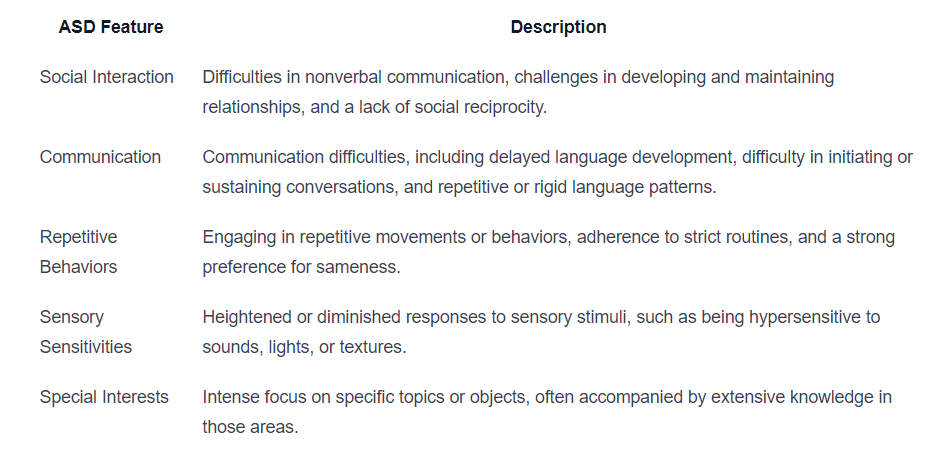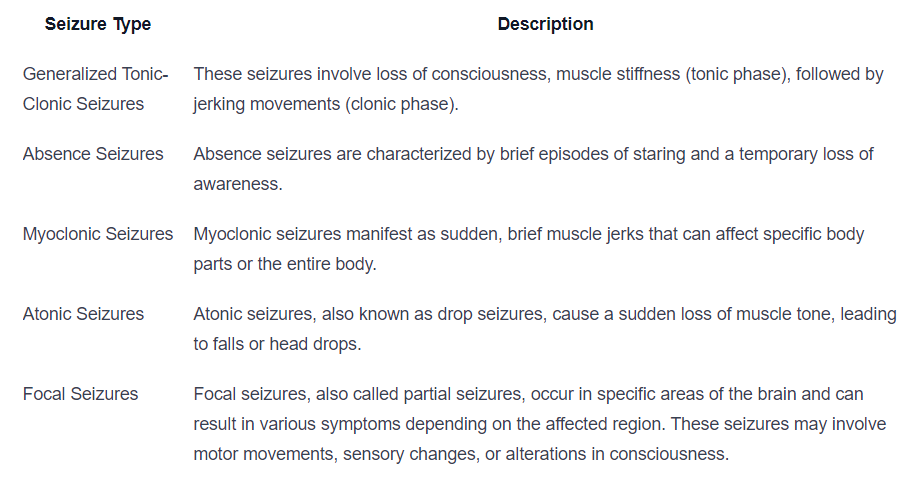Autism Spectrum Disorder and Epilepsy
Discover the comprehensive guide to autism spectrum disorder and epilepsy, unraveling their connection and navigating treatment options.

Understanding Autism Spectrum Disorder (ASD)
Autism Spectrum Disorder (ASD) is a complex neurodevelopmental disorder that affects individuals in varying degrees. It is characterized by challenges in social interaction, communication, and repetitive behaviors. Understanding the overview of ASD and the common characteristics and behaviors associated with it is essential in comprehending its intersection with epilepsy.
Overview of Autism Spectrum Disorder
Autism Spectrum Disorder is a lifelong condition that typically appears during early childhood. It is diagnosed based on a range of symptoms and behavioral patterns. While every individual with ASD is unique, there are some common features that can help identify and understand the disorder.

Common Characteristics and Behaviors of ASD
Individuals with Autism Spectrum Disorder may exhibit a wide range of behaviors and characteristics. Understanding these common features can provide insights into their experiences and challenges.
- Difficulty understanding and interpreting social cues, gestures, and body language.
- Challenges in initiating and maintaining conversations, including difficulty with turn-taking and topic shifts.
- Unusual responses to sensory stimuli, such as covering ears, avoiding certain textures, or seeking sensory input.
- Repetitive movements or behaviors, such as hand flapping, rocking, or lining up objects.
- Resistance to changes in routines or environment, leading to distress or meltdowns.
- Engaging in highly focused interests or obsessions that may be all-consuming.
It is important to note that each individual with ASD may display these characteristics to varying degrees. The severity and combination of these traits can differ significantly from person to person.
Understanding the overview of Autism Spectrum Disorder and the common characteristics and behaviors associated with it is crucial for recognizing and supporting individuals with ASD. By recognizing these features, we can gain a better understanding of how ASD intersects with epilepsy and the unique challenges faced by individuals with both conditions.
Understanding Epilepsy
Epilepsy is a neurological disorder characterized by recurring seizures. Seizures are caused by abnormal electrical activity in the brain, leading to temporary disruptions in normal brain function. Understanding epilepsy is essential in comprehending its intersection with autism spectrum disorder (ASD).
Overview of Epilepsy
Epilepsy affects people of all ages, and it is estimated that around 65 million individuals worldwide have this condition. It is important to note that epilepsy is not a single disorder but rather a group of related conditions, each with its own unique characteristics and triggers.
Epileptic seizures can vary in severity and manifestation. Some individuals may experience mild seizures characterized by brief lapses in awareness or staring episodes, while others may have more intense seizures involving convulsions and loss of consciousness.
Types of Seizures Associated with Epilepsy
There are different types of seizures associated with epilepsy, each with distinct symptoms and patterns. Understanding these seizure types can help in the diagnosis and management of epilepsy.

It's important to remember that epilepsy affects individuals differently, and the types and frequency of seizures can vary significantly from person to person. Proper diagnosis and understanding of the specific seizure types experienced by an individual with epilepsy are crucial for providing appropriate treatment and support.
By gaining a comprehensive understanding of epilepsy, including its overview and the various types of seizures associated with the condition, we can better comprehend its intersection with autism spectrum disorder (ASD). This knowledge lays the foundation for exploring the challenges, diagnosis, treatment, and management strategies for individuals living with both ASD and epilepsy.
The Intersection of ASD and Epilepsy
Individuals with Autism Spectrum Disorder (ASD) are more likely to experience comorbid conditions, and one of the most common co-occurring conditions is epilepsy. Understanding the intersection of ASD and epilepsy is crucial for providing comprehensive care and support to individuals with both conditions.
Prevalence of Epilepsy in Individuals with ASD
The prevalence of epilepsy in individuals with ASD is significantly higher compared to the general population. Research studies have shown that approximately 20 to 30% of individuals with ASD also have epilepsy. This prevalence rate is significantly higher than the estimated 1 to 2% prevalence of epilepsy in the general population.
To gain a better understanding of the relationship between ASD and epilepsy, let's take a closer look at some key statistics:

These numbers highlight the increased risk of epilepsy in individuals with ASD, emphasizing the need for early identification, diagnosis, and appropriate management strategies.
Challenges and Considerations for Individuals with Both ASD and Epilepsy
Having both ASD and epilepsy can present unique challenges for individuals. The combination of these conditions can impact various aspects of life, including behavior, communication, social interactions, and overall quality of life.
Here are some key considerations and challenges faced by individuals with both ASD and epilepsy:
- Increased seizure activity: Individuals with both ASD and epilepsy may experience more frequent and severe seizures compared to those with epilepsy alone. This can have a significant impact on their daily functioning and overall well-being.
- Interference with developmental progress: Epilepsy and seizures can interfere with the developmental progress of individuals with ASD. Seizures may disrupt learning, communication, and social skills development, making intervention and support crucial.
- Complexity of treatment: The presence of both ASD and epilepsy can complicate treatment approaches. Healthcare professionals need to consider the potential interactions between anti-epileptic medications and interventions for ASD, ensuring that treatment plans are tailored to the individual's specific needs.
- Unique behavioral challenges: Individuals with both ASD and epilepsy may exhibit unique behavioral challenges, such as increased aggression, self-injurious behaviors, or difficulties with attention and hyperactivity. These challenges require a comprehensive and individualized approach to intervention and support.
By acknowledging the prevalence of epilepsy in individuals with ASD and understanding the challenges they face, healthcare professionals, educators, and caregivers can provide the necessary support and interventions to improve the overall well-being and quality of life for individuals with both ASD and epilepsy.
Diagnosis and Treatment
When it comes to the intersection of Autism Spectrum Disorder (ASD) and epilepsy, proper diagnosis and treatment are essential for individuals who experience both conditions. This section focuses on the process of diagnosing ASD and epilepsy in individuals and explores the treatment approaches for those who have co-occurring ASD and epilepsy.
Diagnosis of ASD and Epilepsy
Diagnosing Autism Spectrum Disorder (ASD) involves a comprehensive evaluation of an individual's behavior, communication, and social interactions. Medical professionals, such as psychologists, psychiatrists, and developmental pediatricians, typically use standardized assessment tools and conduct thorough interviews with the individual and their caregivers to make an accurate diagnosis.
Similarly, diagnosing epilepsy involves a careful evaluation of the individual's medical history, physical examination, and neurological tests. In some cases, additional diagnostic tests such as electroencephalogram (EEG) or brain imaging may be necessary to confirm the presence of seizures and determine the type of epilepsy.
It is important to note that diagnosing both ASD and epilepsy can be complex, as there is significant overlap in symptoms and characteristics. However, a thorough evaluation by a multidisciplinary team of healthcare professionals can help in identifying and distinguishing between the two conditions.
Treatment Approaches for Individuals with Co-occurring ASD and Epilepsy
Managing individuals with both ASD and epilepsy requires a comprehensive and individualized approach. Treatment strategies often involve a combination of medical interventions, behavioral therapies, and support services.
Medical treatment for epilepsy may include antiepileptic medications prescribed by a neurologist or epileptologist. These medications aim to control or reduce the frequency and severity of seizures. The choice of medication depends on the type of epilepsy, the individual's age, overall health, and any potential interactions with other medications.
In addition to medical interventions, behavioral therapies play a crucial role in managing both ASD and epilepsy. Applied Behavior Analysis (ABA) therapy, speech therapy, occupational therapy, and social skills training can help individuals with ASD develop communication skills, enhance social interactions, and manage challenging behaviors.
Beyond these treatments, the support systems and resources available to individuals with co-occurring ASD and epilepsy are invaluable. Support groups, educational programs, and community organizations can provide guidance, education, and a network of individuals who understand the unique challenges faced by those with both conditions.
It is important to note that each individual is unique, and treatment approaches should be tailored to their specific needs and circumstances. Collaborating with a team of healthcare professionals, including neurologists, psychiatrists, psychologists, and other specialists, can help ensure a comprehensive and effective treatment plan for individuals with both ASD and epilepsy.
Managing ASD and Epilepsy
Individuals with both Autism Spectrum Disorder (ASD) and Epilepsy may face unique challenges in managing their conditions. However, with the right strategies and support systems in place, it is possible to improve their quality of life and effectively manage their symptoms.
Strategies for Managing Symptoms
Managing the symptoms of ASD and Epilepsy requires a comprehensive approach that takes into account the specific needs of each individual. Here are some strategies that can be helpful:
- Medication Management: Working closely with healthcare professionals, individuals with ASD and Epilepsy can explore medication options to control seizures and manage symptoms associated with ASD. It is important to find the right medication and dosage that provide the best seizure control while minimizing side effects.
- Structured Routine: Establishing a structured routine can help individuals with ASD and Epilepsy feel more secure and reduce anxiety. Having consistent daily routines for activities such as meals, bedtime, and therapy sessions can provide a sense of predictability and stability.
- Visual Supports: Visual supports, such as visual schedules, social stories, and visual cues, can be beneficial for individuals with ASD and Epilepsy. These visual aids help in understanding and following daily routines, facilitating communication, and promoting independence.
- Sensory Support: Sensory sensitivities are common in both ASD and Epilepsy. Identifying and managing sensory triggers can help reduce stress and prevent sensory overload. Creating a sensory-friendly environment, using sensory tools, and implementing sensory breaks can be effective strategies.
- Behavioral Interventions: Applied Behavior Analysis (ABA) therapy and other behavioral interventions can assist in addressing challenging behaviors and promoting positive behavior changes. These interventions focus on reinforcing desired behaviors and teaching new skills.
- Communication Strategies: Individuals with ASD and Epilepsy may face communication difficulties. Implementing augmentative and alternative communication (AAC) systems, such as picture exchange communication systems or speech-generating devices, can enhance communication and improve social interactions.
Support Systems and Resources for Individuals with ASD and Epilepsy
Having a strong support system is essential for individuals with ASD and Epilepsy. Here are some support systems and resources that can provide assistance:
- Healthcare Professionals: Collaborating with a multidisciplinary team of healthcare professionals, including neurologists, developmental pediatricians, psychologists, and speech therapists, can ensure comprehensive care and management of both conditions.
- Support Groups: Connecting with support groups, either in-person or online, can provide individuals with ASD and Epilepsy and their families the opportunity to share experiences, exchange information, and seek emotional support.
- Educational Support: Collaborating with educators and school personnel is crucial to ensure that individuals with ASD and Epilepsy receive appropriate educational accommodations and support. Individualized Education Programs (IEPs) and specialized instruction can help address their unique learning needs.
- Community Resources: Many communities offer resources, such as recreational programs, respite care services, and vocational training opportunities, tailored to individuals with disabilities. These resources can provide additional support and enhance the overall well-being of individuals with ASD and Epilepsy.
- Advocacy Organizations: Various advocacy organizations exist to support individuals with ASD and Epilepsy and their families. These organizations can provide information, advocacy services, and access to additional resources.
By implementing effective strategies and utilizing available support systems and resources, individuals with both ASD and Epilepsy can better manage their conditions and lead fulfilling lives. It is important to remember that each individual is unique, and a personalized approach is key to finding the most effective management strategies.
Research and Future Directions
The link between Autism Spectrum Disorder (ASD) and epilepsy has been a subject of extensive research. Understanding this connection is crucial for improving the diagnosis, treatment, and overall well-being of individuals with both conditions. In this section, we will explore the current research on the link between ASD and epilepsy, as well as the promising areas of study for improved understanding and treatment.
Current Research on the Link Between ASD and Epilepsy
Researchers have made significant progress in unraveling the relationship between ASD and epilepsy. Numerous studies have consistently shown a higher prevalence of epilepsy among individuals with ASD compared to the general population. The exact reasons for this association are still being investigated, but several theories have been proposed.
One theory suggests that shared genetic factors contribute to the co-occurrence of ASD and epilepsy. Studies have identified specific genetic mutations and variations that are associated with both conditions. Additionally, abnormalities in brain development and connectivity may play a role in the comorbidity of ASD and epilepsy.
Understanding the specific subtypes of epilepsy that commonly occur in individuals with ASD is also an area of focus. Research has shown that certain seizure types, such as focal seizures and atypical absence seizures, are more prevalent in this population. By identifying these patterns, healthcare professionals can tailor treatments and interventions to address the unique needs of individuals with both ASD and epilepsy.
Promising Areas of Study for Improved Understanding and Treatment
The field of research is continuously evolving, and there are several promising areas of study that hold potential for advancing our understanding and treatment of the intersection between ASD and epilepsy.
1. Neuroimaging and Biomarkers
Neuroimaging techniques, such as magnetic resonance imaging (MRI) and electroencephalography (EEG), are being used to identify structural and functional brain differences in individuals with both ASD and epilepsy. These techniques help researchers uncover biomarkers that may aid in early detection, accurate diagnosis, and personalized treatment approaches.
2. Precision Medicine
Precision medicine, which focuses on tailoring medical treatments to individuals based on their unique characteristics, is an emerging field that offers hope for individuals with ASD and epilepsy. By considering genetic, environmental, and clinical factors, researchers aim to develop targeted interventions that address the specific needs of each individual.
3. Therapeutic Interventions
Exploring novel therapeutic interventions is another area of interest. Researchers are investigating the efficacy of various treatments, such as dietary interventions, neurofeedback, and neuromodulation techniques, in managing both ASD and epilepsy symptoms. These interventions have the potential to improve the quality of life and reduce the burden associated with these conditions.
4. Long-term Outcomes
Gaining a deeper understanding of the long-term outcomes of individuals with both ASD and epilepsy is crucial. Research is focusing on tracking the developmental trajectories, cognitive abilities, and quality of life of this population to identify factors that influence outcomes. This information can guide the development of targeted interventions and support systems.
By advancing research in these areas, we can enhance our understanding of the complex relationship between ASD and epilepsy. This knowledge can lead to more effective diagnostic tools, personalized treatment strategies, and improved outcomes for individuals with both conditions. Continued research efforts hold promise for a brighter future in managing and supporting individuals with the intersection of ASD and epilepsy.
Sources
https://www.ncbi.nlm.nih.gov/pmc/articles/PMC4475437/
https://www.ncbi.nlm.nih.gov/pmc/articles/PMC5739118/
https://www.epilepsy.com/stories/epilepsy-and-autism-there-relationship
Similar articles
We’re here to help you

Our team is here to assist you in this process. Contact us for any assistance.
it’s easy to apply
We Accept Most Insurances
Our in-network insurance partnerships make ABA therapy more accessible to families throughout our service areas.







Our Insurance Process
We'll request your insurance details to help us verify your plan's coverage for ABA therapy. Once we've received this information, we'll walk you through your benefits, including copayments, deductibles and out-of-pocket maximums, so you know what to expect in advance.
Our team will then handle the preauthorization and all the necessary paperwork.
.svg)





















.jpeg)


































.jpeg)




.jpeg)







.jpeg)











.jpeg)
















